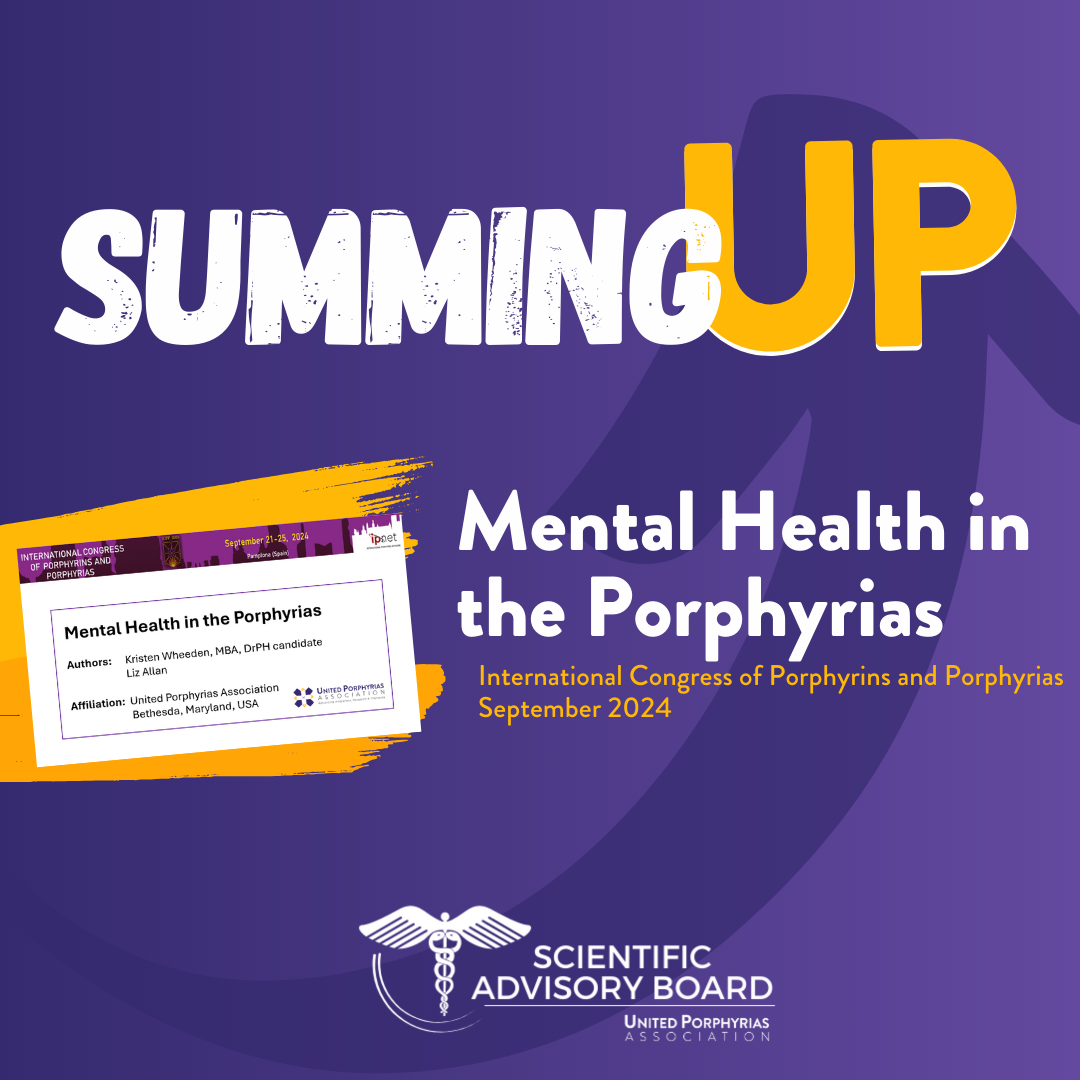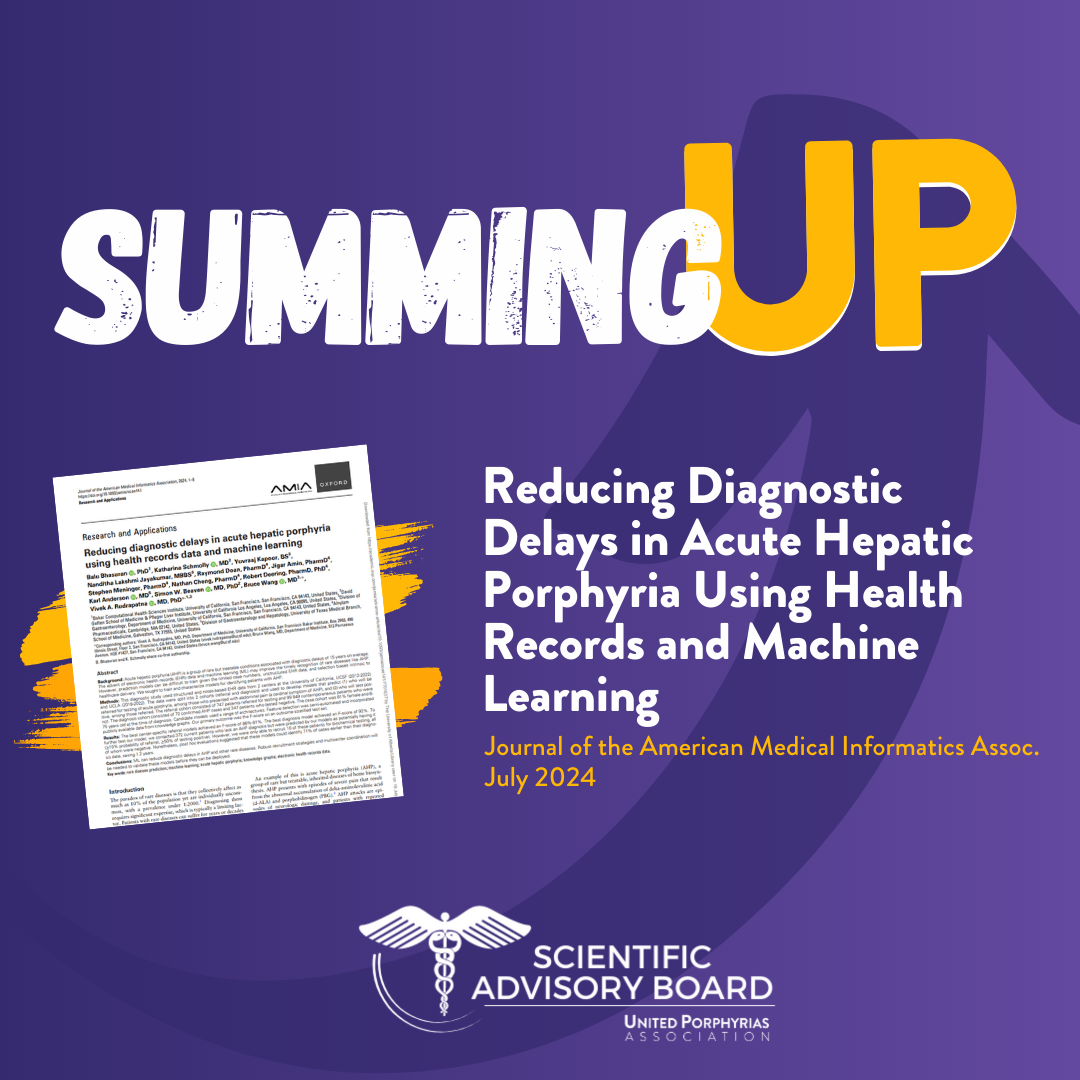Worldwide Patient Experience of Acute Porphyrias
Summing UP features the latest porphyria research in easy-to-understand summaries that have been reviewed and approved by the UPA's Scientific Advisory Board of porphyria experts.
Quantifying the impact of symptomatic acute hepatic porphyria on well-being via patient-reported outcomes: Results from the Porphyria Worldwide Patient Experience Research (POWER) study
Published January 2023
Journal of Inherited Metabolic Diseases Reports
Full article here
Up to this point, most research that has been published about AHP has focused on symptoms and care during an acute attack. This research looks at the full burden of acute hepatic porphyrias (AHP, includes AIP, HCP and VP) on patients from around the world.
What did the POWER study entail?
AHP patients were recruited through patient groups and physicians. After completing screening questions, participants were sent a survey which took about 30 minutes to complete.
The survey used some standardized questions and some questions specific to porphyria. The survey was developed with the input of patients and tested to make sure the information collected would reflect the realities of porphyria.
Survey questions covered several topics, including:
Demographic information such are gender, employment status, family and living situation, etc
Health related information like age at first symptoms, age at diagnosis, treatments received, number of attacks in recent years, number of hospitalizations
Experience of acute and chronic symptoms and their impact on daily life
Experience of anxiety, depression and pain
Impact of porphyria on employment
Who participated in the POWER study?
The POWER study included 92 adults with AHP. Participants were from the United States, Italy, Spain, Australia, Mexico and Brazil. Most patients were female (90%) and had AIP (74%). On average, participants were in their twenties when they first started having symptoms and it took an average of 6.4 years to get a diagnosis.
Participants managed their porphyria using trigger avoidance (64%), and with treatments of IV glucose (57%) and hemin (39%). Patients who were on givosiran were not included in the study.
On average, participants had had 4.5 attacks in the previous two years and had been hospitalized or gone to the emergency department twice because of attacks.
What did the POWER study find?
The study found that AHP had the biggest impact on physical, emotional and financial health with more than 70% of participants ratings their health in these categories as fair or poor.
Physical Health Impacts
Participants identified their most burdensome acute symptoms:
Acute pain (72%)
Muscle weakness (37%)
Acute fatigue (28%)
The most burdensome chronic symptoms were similar to the most burdensome symptoms during an acute attack:
95% had pain, and of those 79% said it had a moderate to severe impact on daily activities
88% had muscle weakness, and of those 85% said it had a moderate to severe impact on daily activities
97% had fatigue, 79% said it had a moderate to severe impact on daily activities
87% had trouble sleeping, with 75% saying the impact was moderate to severe
The nature and location of the pain varied between patients, with 36% identifying lower back pain as the primary pain complaint. More than half of participants (56%) had had a pain-related surgery and 67% were taking pain medication. 37% of participants said their pain no longer responds well to therapy.
The impacts of chronic pain on well-being were similar to findings for patients with other types of chronic pain.
Social, emotional and mental health
Patients reported:
Often feeling lonely or isolated (60%)
Often feeling guilty and upset about their symptoms and disabilities affected those around them (73%)
They would sometimes forget names or words for common objects (71%) and have trouble making decisions (63%)
A majority of patients (63%) felt their friends and family gave them the support they needed.
Special assessments for depression and anxiety were included in the study. According to these assessments:
59% had a score that indicated moderate to severe depression (compared to 7% of the general population)
49% had a score that indicated moderate to severe anxiety (compared to 6% in the general population)
Porphyria had an impact on participant’s personal life and goals:
86% said they had to change or modify goals that were important to them because of AHP
72% reported they were committed to a healthy diet and exercise to prevent AHP symptoms
56% said having AHP pushed them to find a new sense of purpose
53% reported they went out of their way to hide their AHP
Financial Health
AHP had a profound impact on employment. Less than half of the participants were employed, and 61% of participants reported that AHP affected their ability to keep their job.
Of the participants who were employed, those 33% said they had missed work in the previous week and the assessment used to evaluate how their work was affected found a 37% loss of productivity.
Did having more attacks make a difference in patient experiences?
The study compared patients with sporadic (0-5 attacks in the last 2 years) with patients who had recurrent attacks (6 or more attacks in 2 years).
Patients with more attacks had more hospitalizations and emergency department visits and reported more severe pain. This research did not find a significant difference, however, in the perceived impacts of AHP on physical, emotional, cognitive, financial and social health between the two groups:
More than half of participants in both groups had a score indicating moderate to severe depression, and moderate to severe anxiety.
In both groups, pain was one of the top three most burdensome symptoms
Did receiving prophylactic (preventative) hemin or glucose make a difference in patient experiences?
Prophylactic treatments of hemin or glucose are given to prevent attacks from happening (as opposed to being administered when an attack is in progress).
In this study, 38% of patients had received prophylactic treatments. There was no difference in the perceived impacts of AHP on physical, emotional, cognitive, financial and social health between those who did and didn’t have these treatments.
Patients who were receiving prophylactic treatments experienced three times more emergency department visits than the non-prophylaxis group. This doesn’t mean the treatments cause more attacks, they may be receiving these treatments because they have more attacks requiring care to begin with.
Conclusions
This research shows that acute hepatic porphyrias have a substantial impact not only on patients’ physical health but also on their emotional social and financial well-being. There is a need for approaches to care that can reduce attacks, reduce chronic symptoms and improve overall wellbeing.
CONTENT REVIEWED BY UNITED PORPHYRIAS ASSOCIATION SCIENTIFIC ADVISORY BOARD






